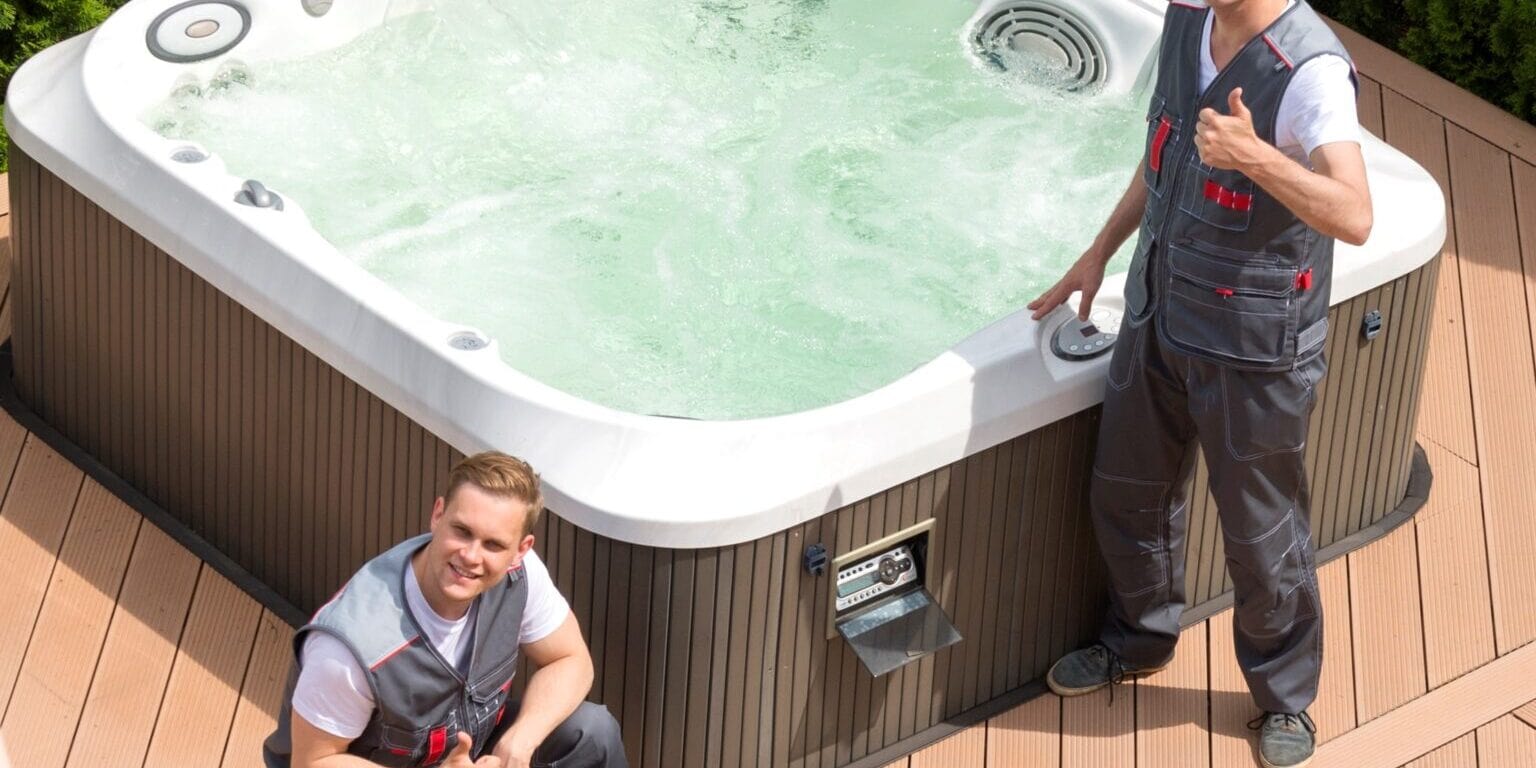Getting a hot tub in your home, there are so many benefits — above all is relaxation! When you have an installed spa, it provides the opportunity for muscle relief, hydrotherapy and a place to relax with your family members or friends. But what few homeowners understand is that a hot tub isn’t just an added luxury, it’s also a high-powered electrical device that needs to be installed correctly and safely.
These are, after all, three elements presents in a standard hot tub. Incorrect installation could cause electric shock, fire or damage. And that’s why you need to know — or to hire someone who knows — how to properly install a hot tub electrically, before you even fill it.
In this post, we’ll review:
- Some of the more stringent — but still safe — electrical installation tips for hot tubs
- The importance of working with a licensed electrician
- The most common wiring mistakes to stay away from
Understanding Hot Tub Electrical Basics
Before we get into the steps, let’s first explain how hot tubs are powered in most cases.
You don’t typically have two different hot tub power connections:
110–120V Plug-and-Play Hot Tubs
- These smaller ones can plug into a regular GFCI-protected house outlet.
- They’re convenient, though they may heat more slowly and have a smaller range of jet power.
220–240V Hardwired Hot Tubs
- These are the more powerful and permanent installations that need to be wired for them poles in your home electrical panel.
- They heat up more quickly and have higher jet performance, but installation should be done by a certified electrician to keep them safe.
Note: Regardless of the type, all hot tubs need to be in accordance with local electrical codes and National Electrical Code (NEC), Article 680 specific to pool and spa installations.
How To Safely Install a Hot Tub In Your Home
Step-by-Step: Hot tub electrical installation guide
1. Hire a Licensed Electrician
Even if you are handy around the house, wiring a hot tub is not a do-it-yourself job. A professional electrician will make sure all safety codes are met and that the circuit is protected enough to accommodate your appliance.
They will:
- Assess your home’s electrical capacity
- Put in the correct breaker (the majority are between 50–60 amps for a 240V spa)
- Ensure correct grounding and bonding
- Verify GFCI protection
Tip: Search online for pool and spa wiring electricians. Inquire if they know anything about Article 680 of the NEC.
2. Install a Dedicated Circuit
Every spa requires its own dedicated GFCI protected circuit.
This means:
- The power supply of the water tub should not be used by other Home appliance.
- The spa should be the only load on the breaker in your main panel.
- A ground fault circuit interrupter (GFCI) sh all be provided to de-energize tool in event of a bacterial.
GFCI protection is permitted to be either:
- In a weatherproof disconnect box near the hot tub
- In your main breaker panel
Code requirement: The GFCI disconnect shall not be located more than 5 ft from the water’s edge of the life support area of a spa but must still be visible from within the tub.
3. Follow the 10-Foot Rule
In order to reduce the potential for electrical shock, the NEC recommends that all wall switches, lighting fixtures and or receptacles should be located at least ten feet from a hot tub.
This keeps splashes or condensation away from live electrical portions.
If you have an outdoor hot tub, double-check:
- The outlet features a weatherproof cover
- All wiring is enclosed in conduit pipe
- The disconnect box is installed on solid non-metallic support
4. Do not Underestimate the Wires and Conduit Size
Selecting the appropriate wire size is critical to ensure proper installation and operation of the hot tub.
For a normal 240V, 50A hot tub:
- Use 6 AWG copper wire for the main line
- Run 4-wire cable (2 hot, a neutral and ground)
- For outdoor use, feed wiring through PVC or flexible metal conduit
Steer clear of aluminum wiring — it may corrode and create resistance problems. 24k copper wire guarantees better signal transfer and lifetime.
5. Proper Grounding and Bonding
- Grounding the electrical system means providing an effective return for an electrical energy to flow that will not cause shock hazard should there be a short-circuit.
- Bonding grounds all metal parts — like pumps, motors and rails — together so they each keep the same voltage.
This step is not optional. An improperly ground hot tub electrical accident is not an uncommon one.
6. Waterproof All Electrical Components
Because hot tubs mix water, steam with electricity waterproofing isn’t optional.
Ensure:
- Every junction box is above ground and weather tight
- All external electrical connections are rated for outdoor use (NEMA 3R or higher)
- Power leads are not stretched over the walking area to keep them away from interfering with plants or acting as a tripping hazard
- Use cord seals and drip loops at any location to keep moisture out of electrical enclosures
7. Inspect and Test Before Use
How to fill a hot tub As you fill your hottub, before use:
- If you can’t reset it, have an electrician troubleshoot using a professional meter
- Test all controls and breakers for proper operation
- Make sure it is turning the heating element, pumps and jets on easily
- Look for any disconnected wires, or exposed wire
You can confidently use your hot tub, with the peace of mind in knowing it is electrically safe.
Hot Tub Wiring Mistakes to Avoid
Dangerous mistakes can happen even to experienced DIYers. So if you’re planning to wire up the hot tub yourself, here are the top mistakes to avoid:
- Circuits that are shared with other appliances (think washer or air conditioner)
- No GFCI protection — deadly this
- Using under-gauge wire that gets hot under load
- Water ingress due to botched conduit fit up
- Neglecting bonding and grounding
- Running cords under rugs, through ceilings or walls or beneath decks
- Disconnect installed too close to hot tub (5 feet or less)
By not doing these things, you could be the difference between a peaceful relax and an electrical disaster.
Preventive Maintenance and Electrical Testing
Even after they’re installed, electrical safety doesn’t stop. Preventative care maintenance is the key to keep your hot tub running successfully and safely!
Every 3–6 months:
- Test the GFCI by pressing the “test” and then the “reset” buttons
- Visually inspect all wires for cracks, disconnection, corrosion or brittleness
- Make sure all lights and heating systems are in good condition
- Pay attention to any abnormal humming/vibrating noises from the motor
Annually:
- Have a professional mechanic check it out, particularly before winter or periods of heavy use
- Replace any frayed cords or plugs
- Torque all grounding and bonding locations
Regular, preventive maintenance will not only help to keep your system safe but also extend the life of your hot tub.
When to Call for Professional Help Right Away
For any of the following signs, call a licensed electrician:
- Tripped breakers that won’t reset
- A burning odor or sparking around the control box
- Flickering spa lights
- Strange tingles upon feeling the water
- Visible melted wiring or corrosion
These are all obvious signs that your electrical system is faulty and it should be rectified by a professional.
Legal and Code Considerations
You may need the following, depending on where you are:
- Building or Electrical permit prior to installation
- Local examination upon the end
Following local ordinances isn’t just about not getting hit with a fine either, it’s so that if something does happen you’re home insurance is still valid.
Note: Before you begin installation, insure that the power is turned off to avoid shorting the test button or causing other damage.
Environmental and Efficiency Tips
When you’re looking to make your hot tub safe and energy-efficient, keep in mind:
- A timer to restrict the hours of heating
- Keeping warm by insulated covers
- Choosing LED lights over bulbs that are incandescent
- Energy Use To reduce elect ric ity bills by sche du ling energy use off peak
With the right wiring and also good habits of use, your spa is environment-friendly as well as budget-friendly.
FAQs: Hot Tub Electrical Installation
Q1: Can I plug my hot tub into a 110v outlet?
Only if it’s a “plug-and-play” model that operates on 110–120V and includes built-in GFCI protection. The bigger 240 volt spas need to be installed by a professional electrician.
Q2: How Far Should the Outlet Be from the Hot Tub?
To code and safe salt pool plS 10 feet from pool to water’s edge to prevent splashing.
Q3: Are you asking if a hot tub requires a permit to install?
In most areas, yes. New installations will also need to have electrical and building permits.
Q4: What type of breaker for a 240v hot tub?
Usually it’s a 50-amp two-pole GFCI breaker that’s needed, but do check the manufacturer specs first.
Q5: How frequent should I inspect my hot tub’s wiring?
Inspect visually every couple of months and have a professional exam at least annually.
Final Thoughts: Safety Before Soak
A hot tub can turn your home into a relaxing oasis — but only if it’s installed with regard to electrical safety. Every detail from GFCI circuits to good grounding counts.
Always follow the manufacturer’s instructions, adhere to local electrical codes and call a professional when in doubt.
Enjoy a safe spa experience!







